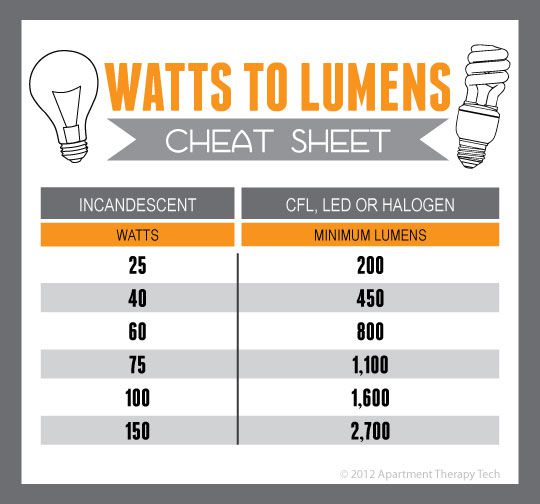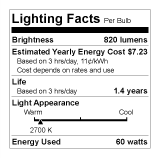Newer bulbs, like halogen incandescent, CFLs and LEDs, last longer and use less energy than traditional incandescent bulbs, which in turn will save you money on your energy bills. But, along with this move to more efficient bulbs comes a new way to shop for them.
For years, people have chosen light bulbs by the watt, learning over time about how bright a typical 40-watt or 60-watt bulb is. But wattage only tells you how much energy a bulb uses, not how bright it is.
With newer light bulbs designed to use less energy, wattage is no longer a reliable way to gauge a light bulb’s brightness, instead we used lumens to measure brightness. A standard 60-watt incandescent bulb, for example, produces about 800 lumens of light. By comparison, a CFL bulb produces that same 800 lumens using less than 15 watts.
WATTS = ENERGY LUMEN = BRIGHTNESS

How Bright is a Light?
This chart shows the number of lumens produced by common incandescent bulbs. If you’re looking to buy a bulb that will give you the amount of light you used to get from a 60-watt bulb, you’ll now look for 800 lumens.
You can use lumens to compare the brightness of any bulb, regardless of the technology behind it, and regardless of whether it’s a halogen incandescent, CFL or LED.
When you shop for light bulbs, you’ll also want to think about light appearance, or color temperature. Light appearance ranges from warm to cool. Warmer light looks more yellow, like the light from a traditional incandescent bulb, cooler light appears more blue.
To find out the light appearance of a light bulb, look at the Lighting Facts label on the package. The Lighting Facts label gives you information you need to compare different bulbs. It tells you:
· Brightness (in lumens)
· Yearly estimated energy cost
· Expected bulb life (in years)
· Light appearance (how warm or cool the light will look)
· Wattage (the energy used)
· If the bulb contains mercury
The label may include the Energy Star symbol, which indicates that a product meets or exceeds high efficiency standards.


On the Bulb
The number of lumens will be printed on the bulb. If the bulb is a CFL, it may be on the bulb’s base. CFLs should also include a web address, for information on safe recycling and disposal. CFLs contain mercury, so cleanup and disposal require some care and attention.
For More Information
Learn more about shopping for light bulbs and other energy saving tips, visit https://www.bchydro.com
